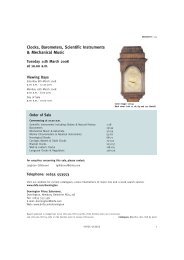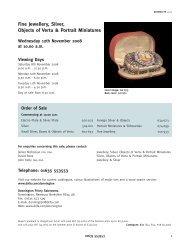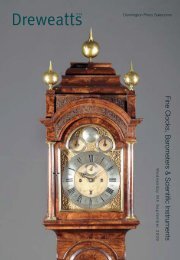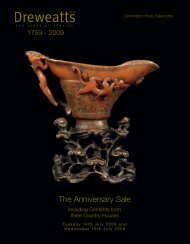Traditional & Contemporary Pictures & Prints - Dreweatt Neate
Traditional & Contemporary Pictures & Prints - Dreweatt Neate
Traditional & Contemporary Pictures & Prints - Dreweatt Neate
You also want an ePaper? Increase the reach of your titles
YUMPU automatically turns print PDFs into web optimized ePapers that Google loves.
26<br />
68<br />
William John Huggins (1791-1845)<br />
The East Indiaman Ceres, in two positions, arriving off<br />
St. Helena<br />
Oil on canvas<br />
Indistinctly signed lower left<br />
75cm x 120cm;<br />
Also<br />
Andrew Robertson, M.A. (1777-1835)<br />
Portrait miniature of Hugh Scott of Draycott (1777-1852),<br />
Captain of the Ceres<br />
Signed with monogram verso and inscribed ' Capt Scott<br />
by A. Robertson, 34 Gerard Street, 1815'<br />
8cm x 7cm, oval<br />
Provenance: Hugh Scott of Draycott, the sitter in the<br />
miniature and Captain of the Ceres, and thence by direct<br />
descent<br />
Hugh Scott was a cousin of Sir Walter Scott of<br />
Abbotsford (Hugh's grandfather was Sir Walter's<br />
Grandfather's elder brother). He is mentioned in Memoirs<br />
of the life of Walter Scott as "Captain Hugh Scott of the<br />
East India Company's Naval Service (now of Draycote<br />
House, near Derby), second son to the late Laird of<br />
Raeburn" page 234. It seems that Hugh Scott gave<br />
Walter Scott 24 pieces of Chinese wallpaper each 12 foot<br />
high by four foot wide enough to "finish the drawing room<br />
and two bedrooms (at Abbotsford)". The wallpaper is still<br />
on the walls at Abbotsford and it would seem highly<br />
probable that Hugh Scott brought this gift back with him<br />
on the Ceres from China.<br />
Sir Walter Scott's brother, Robert Scott, of Rosebank,<br />
was also in the East India Company and the last<br />
Commander of the Neptune.<br />
By the standards of her day, Ceres was a large East Indiaman and was built by John Perry in his<br />
Thames-side yard at Blackwall. Launched on 28th January 1797, she was measured at 1,430 tons<br />
and was 144 feet in length with a 43 foot beam. Originally owned by Thomas Newte, her first voyage<br />
was to India and thence China, departing England on 6th April 1797 and returning on 22nd October<br />
1798. Four further round trips to China followed between 1800 and 1807, after which she was sold to<br />
George Stevens who appointed Captain Hugh Scott as her new master. Under Scott she completed<br />
four more voyages, including her final two which both took in calls at St. Helena, but after returning<br />
home in May 1816 she was sold again and thereafter relegated to a hulk.<br />
Although this location is an unusual one for Huggins, who normally employed the Channel coast off<br />
or near Dover, the number of similar portraits of East Indiamen by him suggests that he may have<br />
been retained by the E.I.C. for the purpose. It is probable that this portrait was done to mark this<br />
vessel's retirement in 1816 and shows her calling at the island of St. Helena, the usual watering<br />
place for E.I.C. ships heading to and from the East.<br />
£20,000-30,000<br />
www.dnfa.com/donnington






